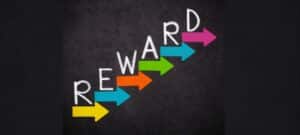How to Boost Sales and Increase Motivation with Gamification

Even the most experienced sales rep will tell you it can be challenging. When you’ve had a series of failed leads land one after another, it can be easy to become demotivated. Fortunately, sales departments have developed a range of traditional and new strategies to combat sales rep disillusionment.
Most of these methods of boosting motivation involve gamification, the process of importing game mechanics and concepts into the workplace to improve employee engagement and performance. Sales teams are one of the best departments to instill game mechanics for motivation.
Let’s look at some statistics for the uptake of gamification within sales.
Four Statistics to Back Up the Gamification Approach
- 89% of survey respondents are more eager to complete gamified tasks, according to Talent LMS.
- 90% of employees report that they feel more motivated at work after the gamification tool is employed.
- Employees experience an average increase in engagement of 48% with gamification.
- 95% of employees say they enjoy gamified tasks in the workplace.
Game mechanics make work more productive and enjoyable, especially in sales teams. This article will examine why that might be and what strategies are best for motivation across various work tasks.
But first, let’s remind ourselves what gamification is and how it works.
How Gamification Works in a Sales Environment

Harvard Business Review defines gamification as “the application of game design principles to change behavior in non-gaming contexts.” We’ve highlighted the two most pertinent parts of the above definition.
- GAME DESIGN PRINCIPLES – elements that make games addictive and enjoyable and instill a sense of competition.
- CHANGE BEHAVIOR – techniques that show employees relate to their work.
So how does this remarkably successful technique work?
The secret lies with the pleasure response neurotransmitter dopamine. Dopamine, the “reward” hormone, works alongside four other hormones—endorphin, serotonin, oxytocin, and cortisol—to regulate our emotional states.
Specifically, dopamine creates a pleasure response when come is achieved, or a beneficial experience occurs. It is triggered by food, sex, entertainment, and the sense of achievement of completing a challenging task.
Dopamine makes a marathon runner cross the line with a feeling of euphoria. It also makes sales employees happy when they receive a top-of-the-leaderboard placement, a bonus, or even a badge of achievement. The only difference is the degree of the dopamine spike.
Gamification finds ways to trigger dopamine release by offering occasional rewards whose size and significance mirror the scale of the achievement. We’ll look at some of these later.
Now, let’s try to find out why sales, particularly, is a fertile ground for the growth of gamification as a motivational strategy.
Why Game Mechanics are Well-Suited to Sales Teams
By their very nature, sales departments are competitive. Unlike many other professional roles, this is partly because selling lends itself to highly specific and visual metrics. Sales personnel are used to being measured across a range of KPIs, including:
- Leads generated.
- Sales conversions.
- Prospecting – calls and emails.
- Revenue generated.
- Targets hit or missed.
These are all highly quantifiable facts that can be graphed over time and compared with predetermined targets, with the average performance of a sales rep and the achievements of the most experienced colleagues.
This makes sales reps highly self-awarding in their performance and means that their managers fully oversee individual, team, departmental, and corporate sales performance.
All the above makes for a highly competitive and stressful environment (triggering another hormone – the stress accompanying cortisol). There is nowhere to hide if you are not achieving your targets and goals.
Therefore, it’s unsurprising that sales leaders are looking for methods to motivate sales reps when flagging and making the working environment more fun and rewarding. That’s where gamification comes in.
Partly, it was always there. Leaderboards are as old as the hills, with chalk blackboards predating sophisticated online sales platforms. Modern gamification techniques are built around an already popular and accepted motivational framework.
16 Leading Gamification Techniques and Strategies for Sales Teams
Let’s turn to some of the most popular and successful game mechanics which can be imported into sales teams to help promote excellence and competition. We’ll present these in no particular order.
1: Leaderboards
Perhaps the oldest of all gamification strategies, ranking individual reps’ daily, weekly, monthly, quarterly, annual, or lifetime performance is standard practice. This technique can also apply to teams.
Modern leaderboards can often be sorted according to specific metrics and periods so that individuals and managers can monitor reps’ experience and achievement levels over time.
To avoid humiliating low-performing reps, some leaderboards only display top performers for 20-50% of reps, meaning nobody is bottom of the heap (although this information remains available to sales leaders). Often, leaderboards reset at regular intervals, giving everyone a chance to excel at different times.
Good sales platforms allow leaderboards to be customized in various ways and offer publicly sharable boards and individual performance dashboards (see 13).
2: Badges
It isn’t only boy scouts and girl scouts who enjoy collecting badges. We all enjoy receiving visual markers of achievement. Think of the elaborate medals that marathon runners collect or the awards given to those who excel in any profession.
On a much smaller scale, many gamification platforms offer badges which are permanent markers of bitesize achievements. It could be anything from sales contests for “most leads followed up” or “biggest single sale” to “salesperson of the week” (see 10).
Crucially, where leaderboard positions come and go and are ephemeral, badges are a permanent indicator of success and can remain on an employee’s record. This can be helpful regarding those monthly, quarterly, or annual review sessions. The permanence of badges makes them a surprisingly good motivator and an easy gamification mechanic to automate too.
3: Leveling up
Just as most popular computer games have increasing challenges and levels of difficulty, sales gamification software platforms allow for the leveling up of employees as they move from trainees to new reps to seasoned professionals.
Gamified training platforms can provide opportunities to ascend proficiency levels by undertaking training programs and additional skills courses. There’s also the possibility of achieving higher level status through a combination of seniority (time in post) plus achieving agreed targets.
Reaching higher levels in the workplace is a major incentive for employees. Gamification allows it to be systematized and customized to suit the hierarchy and set-up of each sales team.
4: Certification
When new staff members are onboarded or undertake training in a new skill, they should be provided with certification. These should be recognized by management and valuable enough to be worth mentioning when employees interview for new positions.
Certification can also be used for specialisms within a team, such as the ability to sell a brand new product, having learned everything there is to know about it, or the ability to sell in a different mode (giving in-person or video product demos, for instance).
Like badges, certification provides tangible proof of reaching a level of achievement, while rewarding those dopamine-enhanced pleasure centers.
5: Kudos from Colleagues
Never underestimate the value of kudos received from colleagues. This is a major feature of social media platforms and self-improvement apps like Strava (which allows fellow exercisers to celebrate one another’s efforts).
In small offices, it may be easy to shout across the room or fire off a congratulatory email, but platforms that create quick and easy mechanisms for this do it better. Instead of breaking their concentration to open an inbox and fire off an email, reps can simply click on a dashboard feature or write a post and tag the individual they want to celebrate.
This is a great mechanism to gamify because it serves a quadruple purpose:
- It makes the sender feel good, having made a generous gesture.
- It makes the recipient feel appreciated at the moment.
- It builds team cohesion, as everyone “pulls together” to hit targets.
- It allows sales leaders and managers to congratulate key employees with ease.
Depending on your platform, congratulatory messages can be combined with the next feature…
6: Celebrations and Notifications
Many platforms allow for fun variations on congratulatory messages, including personalized “triumph” music tracks, virtual gong hits, emojis, and other ephemeral markers of success.
These are designed to be triggered in real-time by automated processes or generated by colleagues or managers to reward or compliment a colleague. They provide a non-verbal alternative to an email or SMS message.
7: Social Communities
Another key feature of digital sales platforms is the ability to build a shared community, which can help counter some of the more insular aspects of competitiveness.
In a functional sales team, there’s a natural tension between the desire to outperform colleagues and a willingness to support one another. By instituting a Slack channel, or some other form of inter-departmental communication and knowledge sharing, you can mitigate some of the “dog eat dog” negativity of sales environments.
These social communities might allow document and tip sharing, collaboration, group, and teamwork. They help managers treat individuals as true team players and help them get to know one another and cohere as a team more quickly.
8: Reward Points
Almost all games, particularly solo games, award points for performance. This allows a player (or sales rep) to measure their current achievement level against past performance and targets. However, as well as having this metric function, points also act as a reward system in and of themselves.
Points can become a real marker of progress for an individual employee and can be further incentivized when they can be exchanged for gifts, services, or other perks. This is generally only possible when the employee reaches a high plateau of achievement.
In a sense, it’s mirroring the air miles concept within a working environment and creating a less explicitly money-orientated bonus scheme. It’s also a more common strategy than you might expect. In the UK, National Health Service employees receive reductions on a large range of goods and services, although is not based upon performance, but merely public sector worker status.
9: Bonuses
One of the more traditional benefits of working in the private sector, particularly in financial or sales-based roles, is the bonuses that top up individual salaries. These incentives can be thought of as gamified elements when they are closely tied to performance.
When bonuses are largely a given or guaranteed in some way, they become less effective as a motivating tool. Employees come to expect them and see them as a discretionary part of their salary.
By contrast, bonuses are valued more highly when rare and hard-won. In an interesting article, Forbes points out that bonuses tend to feel more deserved when they allow for short-term failures that lead to eventual success. Stop new reps from demoralizing by giving them time to get up to speed before they become eligible for a bonus scheme.
10: Employee of the Month
Another classic way to recognize employee success, without monetary cost, is the “employee of the week/month” notion. This should not be an automated recognition of revenue-generating performance because this could lead to the award being given to the same experienced star salesperson many times.
Instead, you can use this market of achievement in a range of ways. For instance, you might award it to:
- The best-performing trainee.
- The most improved employee.
- An employee who has come up with a helpful innovation.
- An employee who has overcome ill health and returned to work.
This way, the award recognizes dedication, diligence, innovation, loyalty, generosity, and other positive traits. After all, you have sufficient ways of rewarding the achievement of KPI targets, so why not recognize other positive behavior?
11: Competitions and Challenges
To prevent the working day from becoming too predictable and mundane, it can help to arrange the occasional competition or challenge. For instance, if a sales team has recently sourced a bunch of new leads and needs to validate them, then a short-term competition could be held to see which rep can validate the most leads within a week.
Or a business might have a new product line, and a sales contest might initiate a challenge to upsell an optional extra. Points, rewards, or a bonus could be awarded to the sales team who succeed best in the upselling task.
These short to medium-term challenges can add extra excitement to a routine task or motivate reps to higher levels of achievement.
12: Progress Bars
This is particularly pertinent in online learning courses, new joiners, or established employees looking to improve their skills. As they progress through mandatory training, participants can see how far they have come and have yet to go.
This may not seem like a gamification technique, but it dates back to the early days of home computer gaming, where games or game levels would take a long time to load. Players didn’t mind waiting if they indicated the time they had to wait.
Likewise, learners don’t mind working through complex subjects if they know the end is in sight. Many learning platforms allow students to pause a subject and return to it later, or another day. A progress bar works as a reminder of where they are in their studies.
In a different context, progress bars can be used to make a new rep’s progress toward achieving proficiency or generating revenue at a level that will convey a particular benefit or bonus.
13: Personal Dashboards
A great innovation in sales platforms is giving each employee their customizable dashboard to access all their metrics, information, contacts, and messages in one place.
Just as a first-person shoot-‘em-up game might display health scores, weaponry, ammunition, and other relevant parameters, a rep’s dashboard can show how they perform regarding tasks performed; conversions achieved, revenue generated, and so forth.
Some dashboards can be toggled between individual and team performance over a range of metrics, which is helpful in workplaces where groups of salespeople compete against one another. The customizable nature of such dashboards allows organizational freedom and personalization while maintaining the metrics that count.
14: Team Competitions
As mentioned above, some sales departments benefit from being divided into teams, like the houses in the Harry Potter books. If innate talent is evenly distributed, these groups will be well-balanced, and no one group will dominate over the others in the long term.
Inter-departmental competition can help promote cohesion within teams and a sense of individual accountability. Reps may work even harder when they know that their performance contributes to the success of a whole team.
Competition winners can be announced periodically or graphed over time to promote ambition. It may be wise to mix these teams regularly to ensure that no single team dominates in the long term.
15: Milestone Markers
A milestone market is slightly different from a badge or celebration in that it indicates longevity within the company. Occasions such as birthdays and anniversaries can be commemorated, which helps boost team morale.
They can also denote the achievement of a new position or grade within a team, a key metric (i.e., 1000 units sold), or even a personal life stage like getting married or having a child. Leaders need to gain permission from individuals to celebrate or mark personal milestones, of course, but it is often appreciated.
These milestone markers can take many forms, from intranet postings to group messages to pop-up notifications. YouTube uses such a system to indicate anniversaries on the platform and send plaques to high-performing, monetized content producers. Another non-sales example would be the silver, gold, and platinum discs given to artists and record companies who achieve impressive album sales goals.
16: Simulations
Lastly, a direct simulacrum of gameplay can be used to test employee knowledge or skill. Going back to the learning machines used since the 1950s to teach keyboard operators vital skills, simulated workplace challenges can be created to test a rep’s mettle before unleashing it on the public.
For instance, a simulation might use text and images to mimic a multichannel communication between a rep and a hesitant buyer. Such methods can roleplay difficult customer scenarios in a safe and virtual space before under-experienced reps are set loose upon the general buyer population.
Such roleplay can be done in in-person classes, but it is increasingly available on online sales platforms, and even companies specializing in sales scenario simulation.
As you can see, there’s no shortage of opportunities to use gamification elements within a workplace, especially in sales.
Maximizing Revenue and Conversions Through Gamification
As we’ve suggested, gamification is a strategy that maximizes employee engagement and motivation. However, for sales leaders and managers, it is also an excellent way to obtain more reliable, more varied metrics on employee performance. Let’s now turn that gamification aspect and look at three major reasons it works so well.
1: Sales Platforms Track Everything
When your team works through a system where email, SMS, phone, and video channels are available through the same portal, every activity can be tracked and measured.
It’s no longer the case that team leaders must constantly walk the floor to ensure reps make the calls they are supposed to. Every call is recorded, timed, and sometimes even auto-transcribed so that you can run sentiment analysis on the customer-rep interaction.
You’ll know exactly how many calls are being made, and how many demos are provided, or follow-up emails are sent in response. Those emails are tracked, too, as are scheduled meetings and deals closed. Leads are tracked, as well as validations and prospecting contacts are recorded.
All this information is available to managers without getting too Big Brother about it. Depending on what sort of analytics you’re running, they can extract all the trends and insights they need.
2: Gamification Keeps Energy Levels High
One of the hardest tasks for any sales leader is keeping morale and ambition levels high. All the gamification tools and methods outlined here contribute to a positive atmosphere where convivial competition and collaboration maximize conversions and revenue.
Whether points, badges, kudos, leveling up, or some other mechanism, reps receive the regular dopamine fix of appreciation and recognition. Managers have time to mentor struggling reps and bring them up to speed since they are less focused on the mood of their sales teams.
Difficult times of the week (after lunch, Friday afternoon) no longer result in deep slumps in performance since you’re stimulating your reps to continued improvement and the hitting of regular targets, which have been accurately pitched between achievability and ambition.
3: Gamification Provides Analyzable Trends to Drive Corporate Strategy
The intelligence that sales departments can deliver from their many interactions with customers can be collated and analyzed for trends in both sales rep performance and customer response.
This information gained at scale due to gamification practices can be passed on to senior management and customer service, R&D, and HR departments. This can help a company become more agile regarding product design, pricing, sales technology, and sales methodology.
In this way, the sales gamification tool allows sales teams to engage in market research, and the automation of mundane tasks frees up time for reflection and insight sharing.
Factors to Consider Before You Use Sales Gamification
Gamification isn’t a magic bullet. It can’t fix problems like badly designed products, misjudged pricing strategies, or a slump in the economy. However, it does offer the potential to apply science and psychology to your sales team to make them happier and more productive.
Here are three considerations to bear in mind:
Don’t bring in too many innovations at once.
It’s better to make several large changes and wait until they bed in before instituting more.
Choose your gamification strategies carefully.
You won’t be able to do everything simultaneously, so prioritize the techniques that fit better with your industry. What works well for teams selling a B2B SaaS product might not be right for reps offering B2C services.
Expect resistance at first.
It’s human nature – nobody likes change, and there may be some cynicism and pushback initially. However, improved results, sales incentives, bonuses, and benefits will quickly convince even the most skeptical rep.
Spinify are the Gamification Experts
Spinify’s gamification platform is designed to boost morale and drive results by making work more engaging and rewarding for employees. By turning work into a game, Spinify motivates employees to push harder and perform better. The platform offers a range of features such as leaderboards, points systems, and badges that create a sense of friendly competition and recognition for achievements.
This not only improves productivity but also fosters a positive work environment, boosting morale and promoting team cohesion. Spinify’s real-time data tracking and analytics provide managers with valuable insights into employee performance, enabling them to identify areas of improvement and reward top performers, further reinforcing positive behavior.
With Spinify’s gamification platform, employees are more motivated, engaged, and empowered to achieve their goals, resulting in improved morale and better outcomes for the business.
For more insights into how to use gamification in the workplace, book a demo today?
Here are some FAQs and answers related to boosting sales and increasing motivation with gamification:
Q: What is gamification in the context of sales?
Gamification in sales involves integrating game-like elements such as points, rewards, competitions, and leaderboards into sales processes to motivate sales teams, enhance performance, and drive results.
Q: How does gamification help boost sales team motivation?
Gamification provides sales teams with clear goals, instant feedback, and rewards for achieving targets, which boosts motivation by making the sales process more engaging and rewarding.
Q3: What are the benefits of using gamification in sales departments?
Gamification in sales helps improve productivity, increase sales performance, foster healthy competition among team members, enhance learning and skill development, and reduce turnover rates by keeping employees motivated and engaged.
Q4: How can gamification strategies be implemented in sales teams effectively?
Effective implementation involves defining specific sales objectives, identifying relevant game mechanics (such as badges for milestones or rewards for top performers), ensuring transparency and fairness in competition, and regularly evaluating and adjusting the gamification strategy based on performance metrics.
Q: How does gamification contribute to employee satisfaction in sales roles?
Gamification enhances job satisfaction by making work more enjoyable, providing recognition for achievements, creating a sense of accomplishment, and promoting a positive work culture focused on continuous improvement and success.
Put those insights into practice.
Set your team up for success by improving their performance through gamification.
Back to blog







